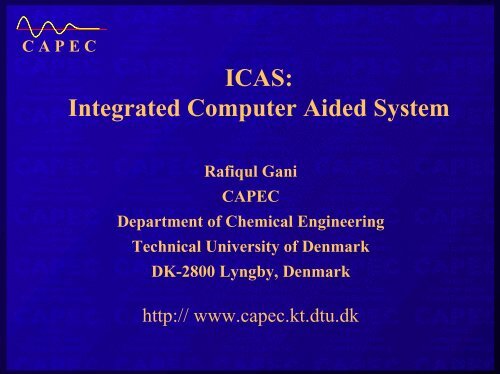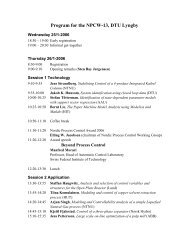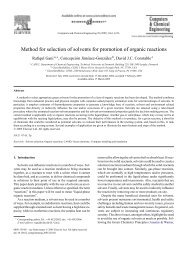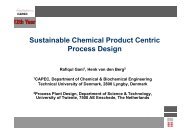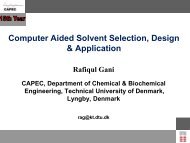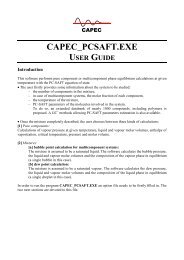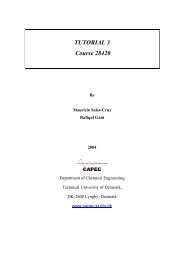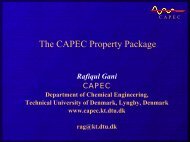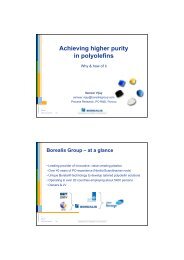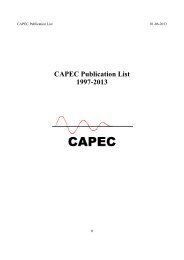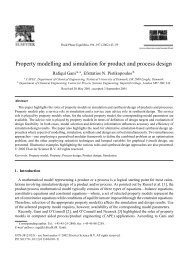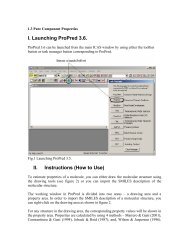ICAS: Integrated Computer Aided System - CAPEC
ICAS: Integrated Computer Aided System - CAPEC
ICAS: Integrated Computer Aided System - CAPEC
Create successful ePaper yourself
Turn your PDF publications into a flip-book with our unique Google optimized e-Paper software.
C A P E C<strong>ICAS</strong>:<strong>Integrated</strong> <strong>Computer</strong> <strong>Aided</strong> <strong>System</strong>Rafiqul Gani<strong>CAPEC</strong>Department of Chemical EngineeringTechnical University of DenmarkDK-2800 Lyngby, Denmarkhttp:// www.capec.kt.dtu.dk
OUTLINEC APEC• <strong>CAPEC</strong> - Brief Introduction• <strong>Integrated</strong> <strong>Computer</strong> <strong>Aided</strong> <strong>System</strong>• Introduction• Main features• <strong>Integrated</strong> process modeling, design,analysis and operation• Examples of application• Conclusions2
Typical Problem in Process Engineering C APECINPUTProcess or Product?Operation or LifecycleOUTPUTInputs and outputs may be known butknowledge of flowsheet, equipmentparameters, condition of operation, ... may bepartially or totally unknown !<strong>ICAS</strong>: Introduction 3
Tools Needed for problem solutionC APEC* Models (Properties, process, …)* Algorithms (synthesis, design, control, …)* Simulation engine (steady state/dynamic)* Knowledge-base (information storage)* Numerical methods (solvers)* Process analysis (environmental impact,safety, energy consumption, operability,…)Note: Simulation engine is only one tool in an integrated system<strong>ICAS</strong>: Introduction 4
<strong>ICAS</strong>ADD TO THE SYSTEMNew Components(Property Prediction)New ReactionsNew Models(Model Generation)PROBLEM DEFINITIONFlowsheetComponents / ReactionsUnits of MeasureConstitutive ModelsWhat to SolveMethod of SolutionSet/Initialize VariablesOutput (Detail/Form)TOOL BOXESDesign / SynthesisSolvent/FluidEquipmentFlowsheetControlParameter EstimationAnalysisEnergyEnvironmentalControlThermodynamicPropertyThermo-modelPhase DiagramsDATABANKSINFORMATIONSTORAGEKinetic ModelExpert <strong>System</strong>SIMULATORMANAGERModel EquationsAdaptationAnalysisSolversBalance EquationsLinearizationDegrees of FreedomAE / ODE / DAEConstraint EquationsReductionIndex / Sparse PatternPDEConstitutive relationsIdentificationPartitioning / OrderingLP / NLPRHS for the units that are solved togetherRHSXMILP / MINLP5
Problem DefinitionProblem ExecutionDrawing ToolsWorkingArea<strong>ICAS</strong> Tools<strong>ICAS</strong> Features 6
<strong>ICAS</strong> Version 5.0C APEC* Property Package (Thermodynamic ModelLibrary; Thermodynamic Model Selection; PureComponent Property Prediction; <strong>CAPEC</strong> Database)* Synthesis & analysis tools (Process DesignStudio, <strong>Computer</strong> <strong>Aided</strong> Process Synthesis <strong>System</strong>,Reaction Analysis <strong>System</strong>,)* Simulation Engines (<strong>ICAS</strong>-SIM, DYNSIM,Batch Records/Operations in <strong>ICAS</strong>)* <strong>Computer</strong> <strong>Aided</strong> Modelling (ModGen, MoT)* Utility (SoluCalc, Phase diagrams & propertycorrelations)7
Design StudioBRICTMSControlParameter estimationModelgenerationFlowsheetgenerationSolventselectionReactionOptimizationPropertypredictionThe integrated tools help to define the simulation problem as wellas solve the individual synthesis/design/analysis problems8
Human activity versus computer activityProblemdefinitionModelcalibration &validation<strong>System</strong>characteristicsModelverificationProblemdataModelsolutionHumanModelconstruction<strong>Computer</strong>The modeling process 9
CAPE-OPEN Modeling Steps! Conversion from “text“ to XML format (not necessary if modelin XML already available)! Import XML-model to MoT (modelling tool-box in <strong>ICAS</strong>)! Analyze model, debug model, define connections (ports, etc.)! Generate PMC (process modeling component - unit plug)! Run PMC from a suitable simulation engineModel equationsXML- ModelComponent generationThrough MoTPMCAnalysisDebugDefineConnectionsModeling through CAPE-OPEN interfaces 10
<strong>ICAS</strong>: Modeling FeaturesSolversModeling ToolsIcas-MoT 11
Demonstration ofProPred - pure component property predictionMoT - Modeling toolbox (from import of textfiles to generation of PMC & COM-objects!)12
ProPred with interface to Molecular Modeling (Chem3D)13
<strong>Computer</strong> aided modeling system: View of translated modelLibraryExplicitImplicitODE<strong>ICAS</strong>-MoT 14
Analysis of the model equations<strong>ICAS</strong>-MoT 15
Solution of the model equations<strong>ICAS</strong>-MoT 16
<strong>Computer</strong> <strong>Aided</strong> Design<strong>ICAS</strong> Design/Synthesis Tools 17
Select/Design Suitable Solvent<strong>ICAS</strong> Design/Synthesis Tools - Demo of ProCamd 18
Process Design Studio - IAnalyzemixture &identifyseparationboundaries.Based on theanalysis,draw themass balancelines &configure thesequence<strong>ICAS</strong> Design/Synthesis Tools 19
Process Design Studio - IISpecify products and calculate theprofiles of temperature andcomposition for assumed reflux ratio– if reflux ratio < minimum, programwill identify the pinch condition<strong>ICAS</strong> Synthesis/Design Tools 20
Process Design Studio - IIIVisualize theprofiles – ifreflux ratio
Process Design Studio - IVFlosheet &design data istransferred andsimulationconvergeswithout anydifficulties22
Definition of interfaces for integration• Specific interfaces depend on specific tool (and releaseversion)• Prerequisites of tool interfacing– Documentation of data structures– Existence of generic methods" Generic tool interfaces# Describing data exchange between types of tools# So far given only on a general level# High specification effort for detailed interface specificationTool ATool BTool type x Tool type y(tool type x) (tool type y)Internal datastructureGeneric datastructureGeneric datastructureInternal datastructure<strong>Integrated</strong> process engineering through CAPE-OPEN 23
Methyl Acetate case study• Design of a plant for Methyl Acetate production– Esterification process: MeOH + AcOH → MeAc + H 2O– 20000 t/y• Characteristics– Well studied processAt least 8 flowsheets inliterature– Complex physicalbehaviour– Both traditional andhybrid processesinvolved– Several CAPE toolsrequiredAcOHMeOHMixer1 barMeAcMeOHH 20AcOH1 barMixer1 barH 20AcOHMeOH5 barMeAc 99.9%Mixer<strong>Integrated</strong> process engineering through CAPE-OPEN 24
Screen shots from application - ISame property modelin simulators &analysis tool-boxDatatransferProcess synthesis tool-box:Pressure-swing distillationsystem<strong>Integrated</strong> process engineering through CAPE-OPEN 25
Screen shots from application - IIGenerate distillationdesign data with PDSTransfer data to“Administrator”<strong>Integrated</strong> process engineering through CAPE-OPEN 26
Screen shots from application - IIIFlowsheet generatedby PDS in <strong>ICAS</strong>Transfer data toPRO-IIFlowsheet in PRO-II, sameproperty model used, alldata (including initialestimates) have been passed<strong>Integrated</strong> process engineering through CAPE-OPEN 27
Screen shots from application - IVSimulation of flowsheet in PRO-II converges very fast. Variousalternatives are generated in <strong>ICAS</strong> (PDS), simulated and optimizedin PRO-II<strong>Integrated</strong> process engineering through CAPE-OPEN 28
<strong>Computer</strong> <strong>Aided</strong> Design/Optimization<strong>ICAS</strong>: Simulation & optimization options 29
<strong>ICAS</strong> & CAPE-OPEN: Highlights* Tools integration* Consistent methodsand data for processand productdevelopment* Helps to solve processengineering problemsmore efficiently* Improves productivityby allowing sharing ofcommon knowledgebetween differentgroups of people* Simultaneous solving& learningMolecularDesign (CAMD)PropertyPredictionKnowledgeDatabases<strong>ICAS</strong>ModelDevelopmentFlowsheetsynthesis andcontrol designStatic andDynamicSimulation30
CONCLUSIONSC APEC• <strong>ICAS</strong> is able to provide the framework for trueintegration of process engineering calculations• Use of <strong>ICAS</strong> means improved efficiency of workand better communication between coworkers(avoid duplication, share common information, ..)• Reduction of time spent by the user in formulatingprocess engineering problems• Increases the efficiency of any simulation system• Currently being applied to solve industrialproblems by <strong>CAPEC</strong> member companies• Allows plug & play with external software (forexample, with Cape-Open interfaces)31


